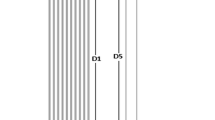Abstract
In the present investigation, we have derived an efficient reduced-order model of the low-voltage cascade electroosmotic micropump. This model can be combined with the equivalent circuit model of straight microchannels to construct a complete model for a microfluidic device, which can be employed to implement modern control schemes. To demonstrate the efficiency of the reduced-order model we employ it to estimate the zeta potentials of many subchannels in the micropump cascade using velocity measurements, which is a preliminary step to the implementation of modern control schemes. It is found that a conjugate gradient procedure employing the reduced-order model estimates accurately the zeta potential variation in the subchannels, which may be caused by adhesion of biomolecules, even with noisy velocity measurements.






Similar content being viewed by others
References
Bleris LG, Kothare MV (2005) Reduced order distributed boundary control of thermal transients in microsystems. IEEE Trans Control Syst Technol 13:853–867
Brask A, Goranovic G, Bruus H (2003) Theoretical analysis of the low-voltage cascade electro-osmotic pump. Sensors Actuators B 92:127–132
Chen L, Li Q, Lee S, Choo J (2008) Development of an electroosmotic pump using nanosilica particle packed capillary. IEEE Sens J 8:488–494
Chen L, Wang H, Ma J, Wang C, Guan Y (2005) Fabrication and characterization of a multi-stage electroosmotic pump for liquid delivery. Sens Actuators B 104:117–123
Hanke M (1995) Conjugate gradient type methods for Ill-posed problems. Longman Scientific & Technology, NewYork
Holmes P, Lumley JL, Berkooz G (1996) Turbulence, coherent structures, dynamic systems and symmetry. Cambridge University Press, Cambridge
Iverson BD, Garimella SV (2008) Recent advances in microscale pumping technologies : a review and evaluation Microfluid Nanofluid. doi:10.1007/s 10404-008-026608
Li D (2004) Electrokinetics in microfluidics. Elsevier, Armsterdam
Loève M (1955) Probability theory. Van Nostrand, New York
Lumley JL (1970) Stochastic tools in turbulence. Academic Press, New York
Matthews MT, Hill JM (2008) Lubrication analysis of the viscous micro/nano pump with slip. Microfluid Nanofluid 4:439–449
Park HM, Cho DH (1996) The use of the Karhunen–Loève decomposition for the modeling of distributed parameter systems. Chem Eng Sci 51:81–90
Park HM, Hong SM, Lee JS (2007) Estimation of zeta potential of electroosmotic flow in a microchannel using a reduced-order model. Biomed Microdevices 9:751–760
Park HM, Lee MW (1998) An efficient method of solving the Navier-Stokes equations for flow control. Int J Number Methods Eng 41:1133–1151
Patankar SV (1980) Numerical heat transfer and fluid flow. Hemisphere, New York
Shinohara K, Sugii Y (2004) High-speed micro-PIV measurements of transient flow in microfluidic devices. Meas Sci Technol 15:1965–1970
Sirovich L (1987) Turbulence and the dynamics of coherent structures. Quart Appl Math 4:561–571
Takamura Y, Onoda H, Inokuchi H, Adachi S, Oki A, Horiike Y (2001) In: Ramsey JM, Van den Berg A (eds) Proceedings of the μTAS 2001, Monterey, CA, USA. Kluwer, Drodrecht, p 230
Author information
Authors and Affiliations
Corresponding author
Rights and permissions
About this article
Cite this article
Park, H.M., Lim, J.Y. A reduced-order model of the low-voltage cascade electroosmotic micropump. Microfluid Nanofluid 6, 509–520 (2009). https://doi.org/10.1007/s10404-008-0326-0
Received:
Accepted:
Published:
Issue Date:
DOI: https://doi.org/10.1007/s10404-008-0326-0




